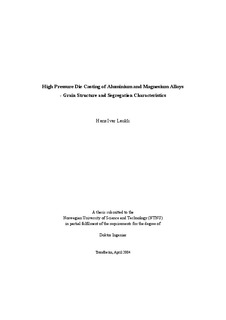| dc.contributor.author | Laukli, Hans Ivar | nb_NO |
| dc.date.accessioned | 2014-12-19T13:25:07Z | |
| dc.date.available | 2014-12-19T13:25:07Z | |
| dc.date.created | 2004-06-04 | nb_NO |
| dc.date.issued | 2004 | nb_NO |
| dc.identifier | 125090 | nb_NO |
| dc.identifier.isbn | 82-471-6324-1 | nb_NO |
| dc.identifier.uri | http://hdl.handle.net/11250/248738 | |
| dc.description.abstract | Cold chamber high pressure die casting, (HPDC), is an important commercial process for the production of complex near net shape aluminium and magnesium alloy castings. The work presented in the thesis was aimed at investigating the microstructure formation in this type of casting. The solidification characteristics related to the process and the alloys control the formation of grains and defects. This again has a significant impact on the mechanical properties of the castings.
The investigations were carried out mainly using the AM60 magnesium alloy and the A356 aluminium alloy. Two different casting arrangements were used: the cold chamber HPDC and the gravity die casting methods, which allowed for different flow and solidification conditions. The microstructures in the castings were investigated using optical microscopy, image analysis, scanning electron microscopy, electron back scatter diffraction measurements and electron probe microanalysis.
In the HPDC experiments, the shot sleeve solidification conditions were investigated primarily by changing the melt superheat on pouring. This significantly affected the microstructures in the castings. The fraction of externally solidified crystals (ESCs) was consistently found to be largest near the gate in both the AM60 and the A356 die castings. This was attributed to the inherent shot sleeve solidification conditions and the flow set up by the plunger movement. When the superheat was increased, a lower fraction of ESCs was found in the castings. Furthermore, a high superheat gave ESCs with branched dendritic/elongated trunk morphology whilst a low superheat generated coarser and more globular ESCs, both in the AM60 and the A356 castings. The ESCs typically segregated towards the central region of the cross sections at further distances from the gate in the die castings.
When a thin layer of thermal insulating coating was applied on the shot sleeve wall in the production of AM60 die castings, it nearly removed all ESCs in the castings. Using an A356 alloy, (and no shot sleeve coating), with no Ti in solution gave a significantly lower fraction of ESCs, whereas AlTi5B1 grain refiner additions induced an increase in the fraction of ESCs and a significantly finer grain size in the castings. The formation of globular ESCs was enhanced when AlTi5B1 grain refiner was added to the A356 alloy.
In controlled laboratory gravity die casting experiments, typical HPDC microstructures were created by pouring semi-solid metal into a steel die: The ESCs were found to segregate/migrate to the central region during flow, until a maximum packing, (fraction of ESCs of ~35-40%), was reached. The extent of segregation is determined by the fraction of ESCs, and the die temperature affects the position of the ESCs. The segregation of ESCs was explained to occur during flow as a result of lift forces.
The formation of banded defects has also been studied: the position of the bands was affected by the die temperature and the fraction of ESCs. Based on the nature of the bands and their occurrence, a new theory on the formation of defect bands was proposed: During flow the solid distribution from the die wall consists of three regions: 1) a solid fraction gradient at the wall; 2) a low solid fraction region which carries (3) a network of ESCs. A critical fraction solid exists where the deformation rate exceeds the interdendritic flow rate. When the induced stress exceeds the network strength, deformation can occur by slip, followed by liquid flow. The liquid flow is caused by solidification shrinkage, hydrostatic pressure on the interior ESC network, and gaps forming which draw in liquid. | nb_NO |
| dc.language | eng | nb_NO |
| dc.publisher | Fakultet for naturvitenskap og teknologi | nb_NO |
| dc.relation.ispartofseries | Doktoravhandlinger ved NTNU, 1503-8181; 2004:57 | nb_NO |
| dc.relation.haspart | Laukli, Hans Ivar; Graciotti, A; Lohne, O; Gjestland, H; Sannes, S. The Effect of Solidification of Metal Prior to Injection in HPDC on the Grain Size Distribution in a Complex Die Casting. NADCA Transactions. 21(T02-035): 1-4, 2002. | nb_NO |
| dc.relation.haspart | Laukli, Hans Ivar; Lohne, O; Sannes, S; Gjestland, H; Arnberg, L. Grain Size Distribution in a Complex AM60 Magnesium Alloy Die Casting. International Journal of Cast Metals Research. 16(6): 515-521, 2003. | nb_NO |
| dc.relation.haspart | Laukli, Hans Ivar; Lohne, O; Arnberg, L; Gjestland, H; Sannes, S. The Effect of Variations in Melt Temperature on the Grain Structures in an AM60 Die Casting. Proceedings of the 6th International Conference on Magnesium Alloys and Their Applications. 6: 182-189, 2003. | nb_NO |
| dc.relation.haspart | Laukli, Hans Ivar. Effects of Grain Refiner Additions on the Grain Structures in HPDC A356 Castings. Metallurgical and Materials Transactions A, 2004. | nb_NO |
| dc.relation.haspart | Laukli, Hans Ivar; Gourlay, Christopher M.; Dahle, Arne K. Migration of crystals during the filling of semi-solid castings. Metallurgical and Materials Transactions A. 36(3): 805-818, 2005. | nb_NO |
| dc.relation.haspart | Gourlay, Christopher M.; Dahle, Arne K; Laukli, Hans Ivar. Segregation band formation in Al-Si die castings. Metallurgical and Materials Transactions A. 35(9), 2004. | nb_NO |
| dc.subject | Materials science | en_GB |
| dc.subject | TECHNOLOGY: Materials science | en_GB |
| dc.title | High Pressure Die Casting of Aluminium and Magnesium Alloys: Grain Structure and Segregation Characteristics | nb_NO |
| dc.type | Doctoral thesis | nb_NO |
| dc.source.pagenumber | 158 | nb_NO |
| dc.contributor.department | Norges teknisk-naturvitenskapelige universitet, Fakultet for naturvitenskap og teknologi, Institutt for materialteknologi | nb_NO |
| dc.description.degree | dr.ing. | nb_NO |
| dc.description.degree | dr.ing. | en_GB |
